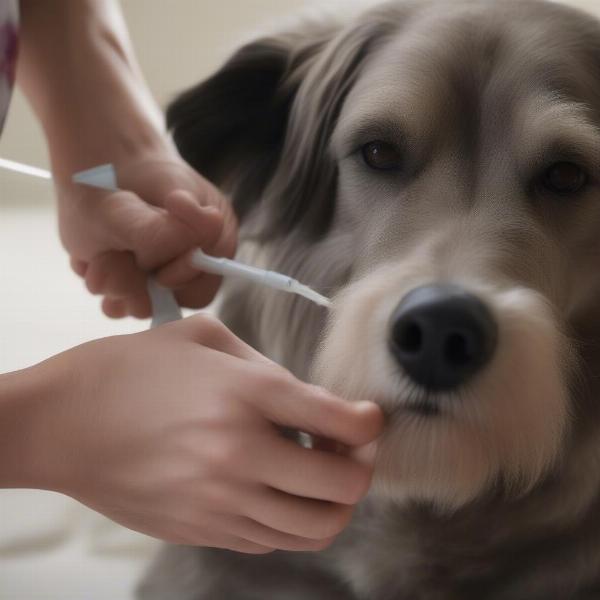Flea infestations are a common problem for dogs, causing discomfort, itching, and even health issues. While over-the-counter flea treatments are available, vet prescribed flea treatment for dogs often offers more potent and targeted solutions. This guide delves into the world of vet-prescribed flea treatments, exploring their benefits, types, and how to choose the best option for your furry friend.
Choosing the right flea treatment for your dog can feel overwhelming with so many options available. While over-the-counter medications might seem convenient, vet prescribed flea treatment for dogs often provides a more comprehensive and effective approach, especially for persistent or severe infestations. These treatments are typically stronger and target fleas at different stages of their life cycle, preventing re-infestation. Your veterinarian can tailor their recommendation to your dog’s specific needs, considering factors like age, breed, health status, and lifestyle.
Understanding the Importance of Vet-Prescribed Flea Treatment
Why opt for a vet-prescribed flea treatment over readily available options? Your vet can diagnose the specific type of flea infestation and recommend a treatment tailored to your dog’s needs. They consider factors like age, breed, health conditions, and the severity of the infestation. Vet-prescribed treatments are often more potent and effective than over-the-counter solutions, especially in cases of heavy infestations or flea allergies.
Types of Vet-Prescribed Flea Treatments for Dogs
Several vet-prescribed flea treatments are available, each with its own mechanism of action:
- Oral Medications: These chewable tablets are easy to administer and typically kill adult fleas quickly. Examples include NexGard, Bravecto, and Simparica.
- Topical Treatments: Applied directly to the skin, these solutions spread through the dog’s coat and kill fleas on contact. Examples include Advantage, Frontline Plus, and Revolution.
- Injections: In some cases, your vet might recommend an injectable flea treatment that provides long-lasting protection.
Choosing the Right Flea Treatment for Your Dog
How do you select the best vet prescribed flea treatment for dogs? Consider the following factors:
- Age and Breed: Some treatments are not suitable for puppies or certain breeds.
- Health Conditions: If your dog has any underlying health issues, discuss these with your vet.
- Lifestyle: A dog that swims frequently might require a waterproof treatment.
- Severity of Infestation: A severe infestation might require a more aggressive treatment approach.
What are the common side effects of vet-prescribed flea treatment for dogs? While generally safe, some dogs may experience mild side effects such as temporary skin irritation, vomiting, or lethargy. Always consult your veterinarian if you notice any unusual symptoms after administering flea treatment.
How to Administer Vet-Prescribed Flea Treatments
Always follow your veterinarian’s instructions carefully when administering flea treatments. For oral medications, ensure your dog chews the tablet completely. For topical treatments, apply the solution to the skin at the back of the neck, where the dog cannot lick it off.
 Applying topical flea treatment to a dog
Applying topical flea treatment to a dog
Conclusion
Vet prescribed flea treatment for dogs offers a safe and effective way to combat flea infestations and protect your pet’s health. By working closely with your veterinarian, you can choose the best treatment option for your dog’s individual needs and ensure they remain happy, healthy, and flea-free.
FAQ
- How often should I apply flea treatment to my dog? This depends on the specific product and your veterinarian’s recommendation. Some treatments are monthly, while others provide longer-lasting protection.
- Can I use vet-prescribed flea treatments on pregnant or lactating dogs? Consult your veterinarian before using any flea treatment on pregnant or lactating dogs.
- What should I do if my dog has a flea allergy? Vet-prescribed flea treatments are crucial for managing flea allergies. Your vet might also recommend additional medications to alleviate allergic reactions.
- Are there any natural alternatives to vet-prescribed flea treatments? While some natural remedies exist, they are often less effective than vet-prescribed treatments, especially for severe infestations.
- How can I prevent flea infestations in my home? Regular vacuuming, washing bedding, and treating the environment with flea sprays can help prevent infestations.
- Can fleas transmit diseases to dogs? Yes, fleas can transmit diseases such as tapeworms and Bartonellosis.
- How can I tell if my dog has fleas? Common signs include excessive scratching, biting at the skin, and the presence of flea dirt (small black specks) in the fur.
Related Articles on ILM Dog
At ILM Dog, we’re committed to providing dog owners worldwide with reliable, practical information on all aspects of dog care. From breed selection and health advice to training tips and product recommendations, we offer expert guidance to help you nurture your canine companion. Whether you’re a new dog owner or a seasoned expert, ILM Dog is your trusted resource for all things dog-related. Contact us today for personalized advice: Email: [email protected], Phone: +44 20-3965-8624.